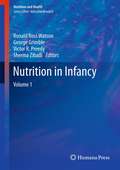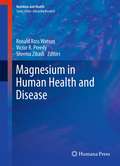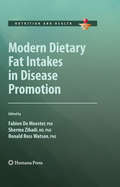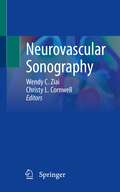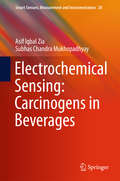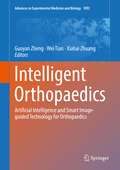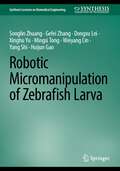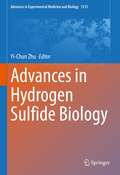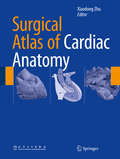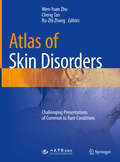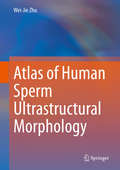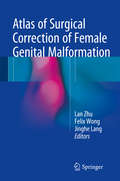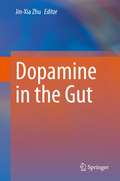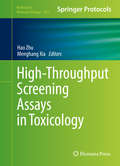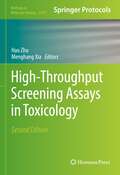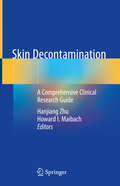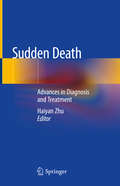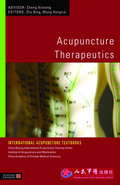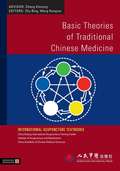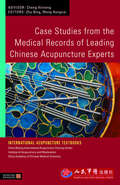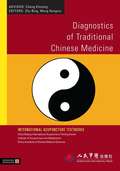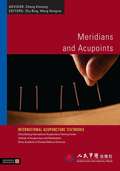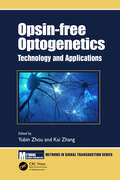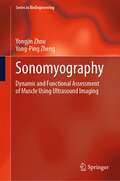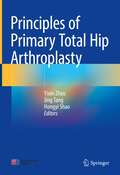- Table View
- List View
Nutrition in Infancy: Volume 1
by Sherma Zibadi Ronald Ross Watson Victor R. Preedy George GrimbleNutrition in Infancy: Volume 1 is a very useful resource for all clinicians treating and preventing nutritional problems in infants. This volume covers a wide range of topics that support wellness in infants through the prevention and treatment of infectious diseases, malnutrition, and developmental and genetic abnormalities. A variety of chapters deal with nutrients for infants with disabilities, surgery, and other special needs. <P><P> Special emphasis is provided for clinicians treating the millions of children in developing countries whose death is promoted by undernutrition or malnutrition. The next sections discuss the health benefits of supplementation and breast feeding and methods to improve use of berast feeding and it's duration. In Nutrition in Infancy: Volume 1, all of these facets of nutrition and nutritional therapy are covered in a precise and practical way. The latest developments in diagnostic procedures and nutritional support are also included. Written by a group of international experts, this volume is an indispensable new reference for clinicians with an interest in the nutrition and health of pregnant mothers and their infants.
Magnesium in Human Health and Disease
by Sherma Zibadi Victor R. Preedy Ronald Ross WatsonMagnesium is an essential mineral which is required for growth and survival of humans. Since magnesium is a mineral and not synthesizable it must be obtained through dietary foods and/or supplements. Magnesium in Human Health and Disease reviews the benefits of magnesium supplementation to reach recommended intakes as well as provides new research that suggests how reaching levels above the recommended intakes can promote health and treat various diseases. Magnesium deficiency can cause low serum potassium and calcium levels, retention of sodium, and low circulating levels of regulatory hormones. These changes in nutrients cause neurological and muscular symptoms such as tremor and muscle spasms. Further magnesium deficiency causes loss of appetite, nausea, vomiting, personality changes and death from heart failure. Causes of magnesium deficiency include alcohol abuse, poorly controlled diabetes, excessive or chronic vomiting and/or diarrhea. Thus the effects of inadequate and deficient intakes or levels of magnesium is critical to health and are reviewed by the expert clinicians in this book. Magnesium in Human Health and Disease provides the most current research to support the potential benefits or lack thereof for normal and high supplementation with magnesium. Animal model research and early human trials are reviewed to document other disease states such as hypertension, cholesterol level, type 2 diabetes and cardiovascular disease that would benefit from increased magnesium.
Modern Dietary Fat Intakes in Disease Promotion
by Sherma Zibadi Fabien De Meester Ronald Ross WatsonThe industrial and agricultural revolutions have dramatically changed our lifestyles including where we get foods and what we eat. Modern diets have moved away from a close association with historically beneficial foods and diets towards foods and diets with increased fats and contaminants and with much lower intakes of fruits and vegetables. Modern Dietary Fat Intakes in Disease Promotion focuses on the scientific evidence that define such risks in modern diets with the consequences of increased illness, cancer and disease. There is also an emphasis on methods to reverse negative components of modern diets for health improvement. The volume is divided into six sections. The first section focuses on the behavioral aspects of eating and is followed by sections on fats, obesity and cardiovascular disease and fats and cholesterol. The fourth section contains novel chapters on the potential for contaminants in fats and oils to increase risk of illnesses. The fifth section examines fat induced disease and ill-health. The sixth section looks at dietary and pharmaceutical approaches to modify fat-induced disease and ill-health. Each section contains chapters that address treatment options as well as prevention strategies. Modern Dietary Fat Intakes in Disease Promotion provides practical, data-driven resources based upon the totality of the evidence to help the reader understand both the basics as well as treatments and preventive strategies that are involved in balancing the fats in one's diet as well as within one's body.
Neurovascular Sonography
by Wendy C. Ziai Christy L. CornwellThis book provides a comprehensive and concise, review of the fundamental concepts and clinical indications for Transcranial Doppler (TCD) imaging. An overview of the physics of ultrasonography as it pertains to TCD is presented, as well as neuroanatomy and cerebrovascular physiology in healthy and diseased states. Recommended protocols for neuroimaging are reviewed and serves as a guide for existing neurovascular laboratories and medical systems seeking to develop laboratories that are in need of a guide to establish their own protocols. The most common, relevant and challenging clinical conditions where TCD is incorporated to assist with patient management are discussed. In addition, chapters provide a framework for building a neurovascular laboratory, including necessary equipment, steps to obtain national accreditation by accrediting bodies, and reimbursement procedures for tests performed. The book concludes with “clinical pearls” and “tricks of the trade”, which serve as a commentary to guide physicians and neurosonologists on best-practices for TCD acquisition and interpretation.
Electrochemical Sensing: Carcinogens in Beverages
by Asif Iqbal Zia Subhas Chandra MukhopadhyayThisbook describes a robust, low-cost electrochemical sensing system that is able todetect hormones and phthalates - the most ubiquitous endocrine disruptorcompounds - in beverages and is sufficiently flexible to be readily coupledwith any existing chemical or biochemical sensing system. A novel type of silicon substrate-based smart interdigitaltransducer, developed usingMEMS semiconductor fabrication technology, is employed in conjunction with electrochemical impedance spectroscopy to allow real-time detection andanalysis. Furthermore, thepresented interdigital capacitive sensor design offers a sufficient penetrationdepth of the fringing electric field to permit bulk sample testing. The authorsaddress all aspects of the development of the system and fully explain its benefits. The book will be of wide interest to engineers, scientists, and researchersworking in the fields of physical electrochemistry and biochemistry at theundergraduate, postgraduate, and research levels. It will also be highly relevantfor practitioners and researchers involved in the development of electromagneticsensors.
Intelligent Orthopaedics: Artificial Intelligence And Smart Image-guided Technology For Orthopaedics (Advances in Experimental Medicine and Biology #1093)
by Xiahai Zhuang Wei Tian Guoyan ZhengThis book introduces readers to the latest technological advances in the emerging field of intelligent orthopaedics. Artificial intelligence and smart instrumentation techniques are now revolutionizing every area of our lives, including medicine. The applications of these techniques in orthopaedic interventions offer a number of potential benefits, e.g. reduced incision size and scarring, minimized soft tissue damage, and decreased risk of misalignment. Consequently, these techniques have become indispensable for various orthopaedic interventions, which has led to the emerging field of intelligent orthopaedics. Addressing key technologies and applications, this book offers a valuable guide for all researchers and clinicians who need an update on both the principles and practice of intelligent orthopaedics, and for graduate students embarking on a career in this field.
Robotic Micromanipulation of Zebrafish Larva (Synthesis Lectures on Biomedical Engineering)
by Songlin Zhuang Gefei Zhang Dongxu Lei Xinghu Yu Mingsi Tong Weiyang Lin Yang Shi Huijun GaoThis book offers readers a series of robotic methods for manipulating zebrafish larva, one of the most popular model vertebrates widely used in biomedical research and clinical applications. The authors leverage advanced control theories, image processing algorithms, and artificial intelligence to establish a robot-assisted automated or semi-automated zebrafish larva-targeted micromanipulation system for different experimental purposes. The methods presented are generic and can be translated to manipulate other types of biological objects, such as embryos or cells. Coverage includes topics that span the procedures of manipulating zebrafish larva, such as in-plane positioning, three-dimensional orientation, deformation-controllable immobilization, organ-targeted microinjection, whole-organism imaging, and high-throughput trajectory tracking of zebrafish larvae group movement.Robotic Micromanipulation of Zebrafish Larva is written in a simple, clear, and easy-to-read style. It is an ideal reference for academic researchers and biomedical operators. It is also a valuable resource for students learning robotics, control and system theories, image processing, artificial intelligence, and biomedical engineering.
Advances in Hydrogen Sulfide Biology (Advances in Experimental Medicine and Biology #1315)
by Yi-Chun ZhuHydrogen sulfide (H2S) has emerged as an important gas signalling molecule in a series of organs/tissues, on the diseases of which it plays protective roles, such as proangiogenic effects in ischemic tissues, antiapoptotic effects in the cardiomyocytes, regularization of fatal arrhythmia in myocardial infarction, amelioration of inflammation in autoimmune diseases, modification of neuronal transmission, increase in sodium excretion from the kidney, and amelioration of insulin resistance, etc. This book focuses on the effect of hydrogen sulfide in cardiovascular system, immune system, nervous system, kidney, as well as on the metabolism of glucose and lipids and regulation of ion channels and so on. This book also provides the advances in the understanding of endogenous H2S metabolism and H2S protein targets, as well as H2S donors. It will benefit researchers in both academics and industry working on the underlying mechanism of H2S field and the future of translational medicine of H2S.
Surgical Atlas of Cardiac Anatomy
by Xiaodong ZhuThis Atlas is illustrated with rich pictures of cardiac surgical specimens. It not only contains normal heart specimens but also dissects those specimens, taking pictures from various angles to create a three-dimensional representation. It also includes reviews of the specimens' pathological reviews. Chapter 1 through 10 introduce the normal anatomy of the cardiac chambers and surgical approaches to the heart, while chapter 11 through 28 describe 18 kinds of congenital heart defects. There are a total of over 1,000 images and illustrations in this book, which will be of great interest not only to the surgeons, but also to the cardiologists, anaesthesiologists and surgical pathologists.
Atlas of Skin Disorders: Challenging Presentations of Common to Rare Conditions
by Wen-Yuan Zhu Cheng Tan Ru-Zhi ZhangThis book was written to assist the dermatologists and practitioners in the management of rare and challenging skin disorders. It is the most valuable collection of such skin disorders from more than 274 outstanding contributors over 4 decades in China. In this book, a comprehensive coverage of about 387 conditions are illustrated by 1215 superb images, and each is introduced with an initial summary of clinical characters. This atlas incorporates a wide range of skin disorders from the mildest and common conditions to the most severe conditions. The objective of this book is to provide readers with a clinical reference, which can be easily approachable and possesses the necessary expertise to sharpen a dermatologist’s diagnostic and clinical acumen.
Atlas of Human Sperm Ultrastructural Morphology
by Wei-Jie ZhuThis atlas provides ultrastructural morphological images of human spermatozoa. Sperm morphology plays an essential role in sperm-oocyte interactions and early embryonic development, and human sperm ultrastructural morphology offers a valuable reference tool for assessing certain etiologies of male infertility and reproductive failure. However, the ultrastructural morphology of human sperm has not been systematically evaluated or thoroughly described in the literature. Using 470 original and unpublished images, the book shows various ultrastructural morphological phenotypes; defects of the sperm head, neck, middle piece, principal piece, and terminal piece; as well as artefacts of sperm ultrastructural morphology and phenomena related to inadequate preparation, demonstrating many sperm phenotypes and surface structural appearances for the first time. As such, it helps researchers and practitioners in andrology, reproductive medicine, and reproductive pathology gain a better understanding of human sperm ultrastructural morphology.
Atlas of Surgical Correction of Female Genital Malformation
by Lan Zhu Felix Wong Jinghe LangThis book discusses a rare form of female genital tract abnormality. It starts with an introduction to modern pre-surgical diagnostic tools, including hysterosalpingography, 3D ultrasound and MRI. From external to internal genitalia, this book introduces all commonly known malformations, as well as a variety of rare congenital malformations of the female genital tract. For each malformation, it includes indications, timing, surgical illustration, contraindication, anaesthesia, surgical procedure, postoperative treatment and key points. In order to facilitate understanding, extensive illustrations and surgical images are also provided. This text offers a comprehensive guide for clinicians, helping them to accurately diagnose and treat these patients, who may present with different clinical manifestations. The authors are well-known gynecologists actively involved in the diagnosis and treatment of difficult diseases.
Dopamine in the Gut
by Jin-Xia ZhuDopamine is widely present in the central and peripheral nervous systems, as well as in non-nervous systems. Parkinson's disease is well recognized as a dopaminergic neurodegenerative disorder, and affected patients often show early signs of gastrointestinal disorders at initial stages of the disease. Apart from the changes that occur in emotion, movement behaviors, learning and memory, metabolism etc., dopamine has also been demonstrated to play very crucial roles in the functional regulation of peripheral organs such as the heart, blood vessels, kidneys, and gut. Most recently, dopamine function in the gut has received enormous attention. Not only does dopamine regulate gut motility, ion transport, and mucosal barrier, but it is becoming more pertinent that more than 60% of dopamine in the body stems from the gut, which has not yet been properly addressed and substantially explored. Therefore, this book will discuss the brain-gut axis by providing novel and significant insight into the essence of gut-derived dopamine in mammals. It aims to inspire further research on dopaminergic regulation of gut function and disease genesis.
High-Throughput Screening Assays in Toxicology
by Hao Zhu Menghang XiaThis book focuses on recently developed High Throughput Screening (HTS) assay protocols, many involved in the ToxCast and/or Tox21 initiatives, and the relevant HTS data analysis techniques. Divided into three sections, in vitro assays, in vivo assays, and computational techniques to analyze HTS data are all examined. Written for the highly successful "Methods in Molecular Biology" series, most chapters include introductions to their respective topics, lists of the necessary materials and reagents, step-by-step, readily reproducible laboratory protocols, and tips on troubleshooting and avoiding known pitfalls. Authoritative and practical, "High Throughput Screening Assays in Toxicology" serves as a valuable reference resource for translating new HTS techniques into standardized chemical toxicity assessment tools in order to advance modern toxicology research to a new era where HTS techniques can partially replace the prevailing animal models.
High-Throughput Screening Assays in Toxicology (Methods in Molecular Biology #2474)
by Hao Zhu Menghang XiaThis second edition volume expands on the previous edition by exploring the latest advancements in high throughput screening (HTS) in toxicity studies by using in vitro, ex vivo, and in vivo models. This volume also covers the application of artificial intelligence (AI) and data science to curate, manage, and use HTS data. Written in the highly successful Methods in Molecular Biology series format, chapters include introductions to their respective topics, lists of the necessary materials and reagents, step-by-step, readily reproducible laboratory protocols, and tips on troubleshooting and avoiding known pitfalls. Cutting-edge and thorough, High Throughput Screening Assays in Modern Toxicology, Second Edition is a valuable resource for scientists pursuing chemical toxicology research. This book will aid scientists and researchers in translating new HTS techniques into standardized chemical toxicology assessment tools that can refine, reduce, and replace animal testing.
Skin Decontamination: A Comprehensive Clinical Research Guide
by Hanjiang Zhu Howard I. MaibachThe skin is the first line of defense against chemical warfare agents including nerve agents and toxic industrial chemicals, providing a possible barrier or delay to systemic distribution. However, some chemicals act directly on the skin including vesicants sulfur mustard and corrosive compounds such as strong acids or bases, and do not have to gain access to systemic circulation to cause extensive skin damage. Early and rapid skin decontamination is extremely important following exposure to chemical warfare agents and toxic industrial chemicals because it decreases serious skin damage to the patient and, potentially, their doctor. This multi-authored international text pulls together a century of decontamination research and helps the reader expedite solutions that will decrease morbidity and mortality. Complete with dozens of hiqh quality photographs and illustrations, Skin Decontamination aids industrial hygiene, dermatology, occupational physicians and those involved in the public health arena.
Sudden Death: Advances in Diagnosis and Treatment
by Haiyan ZhuThis book provides up-to-date guidance on the diagnosis and treatment of sudden death, including sudden cardiac and non-cardiac death. Sudden death (SD) has become a major challenge confronting not only cardiologists, but also specialists in respiratory medicine, endocrine medicine, infectious diseases, etc. Chronic diseases are also among the causes of SD. This book summarizes the occurrence of SD, especially in specific groups (such as women, young and middle-aged groups), its causes, predisposing factors, lifestyle, morbidity, point of care testing, and advanced treatment methods including extra-corporeal membrane oxygenation, cardiopulmonary resuscitation and hypothermia treatment. In order to improve the early diagnosis, prevention and treatment of SD in clinical practice, the book also provides extensive data on its pathophysiological mechanism, epidemiology and etiology, together with detailed analyses.
Acupuncture Therapeutics
by Bing Zhu Hongcai WangAcupuncture can be a very effective way of strengthening the body's resistance to illness, and of eliminating potentially harmful pathogens. This book provides a complete overview of the principles involved in distinguishing between different syndromes of illness in patients, and of selecting and administering appropriate treatments. The book describes the functions of acupuncture within the wider context of traditional Chinese medicine, and explains the principles involved in identifying and treating different illnesses and complaints. A large portion of the book is devoted to describing how to diagnose and treat more than 130 different conditions, including headaches and angina, asthma, depressive disorders, dementia, and acne. This comprehensive textbook, compiled by the prestigious China Beijing International Acupuncture Training Center (CBIATC), under the editorial directorship of leading Chinese practitioners Zhu Bing and Wang Hongcai, is an invaluable reference for the advanced student or practitioner of traditional Chinese medicine.
Basic Theories of Traditional Chinese Medicine
by Bing Zhu Hongcai WangTraditional Chinese medicine has a long and complex history, yet the basic principles at the heart of practice have remained the same for hundreds of years. Without a solid understanding of these fundamental theories, effective practice is impossible, and this book provides a complete introduction to everything that students and practitioners, both new and experienced, need to know. The book describes and explains all of the fundamental principles of Traditional Chinese Medicine, including yin/yang, the five elements, the 'zang and fu' organs, Zang Xiang, Qi, and the meridians and collaterals of the body. Explaining not only the principles upon which these elements work, but also how they interrelate, the book describes how they can be used in practice to identify, treat and prevent ill-health and disease. This thorough and accessible textbook, compiled by the China Beijing International Acupuncture Training Center (CBIATC), under the editorial directorship of leading Chinese clinicians Zhu Bing and Wang Hongcai, is essential reading for students of traditional Chinese medicine, and is also a useful basic reference for TCM practitioners.
Case Studies from the Medical Records of Leading Chinese Acupuncture Experts
by Bing Zhu Hongcai WangThe ability to apply complex theory to practice is a vital skill for acupuncturists. Case studies and medical records are an extremely useful resource for understanding how to differentiate between different syndromes, and provide invaluable precedents for deciding upon appropriate methods of diagnosis and treatment. This book presents a collection of real case studies of patients who have been treated by prominent acupuncture practitioners in China. The case studies are divided into five sub-categories of disease, and include information on the patient's medical history, presenting complaint, symptoms, tongue and pulse examination, diagnosis, treatment, and prescription as well as the Western diagnosis. More than 170 different case studies are included in the book, covering 73 different types of syndromes and disease. A useful appendix with the Chinese and English names for these syndromes is also included. Compiled by leading experts at the China Beijing International Acupuncture Training Center (CBIATC), under the editorial direction of leading Chinese clinicians Zhu Bing and Wang Hongcai, this book is a useful reference for acupuncture practitioners and students at all levels.
Diagnostics of Traditional Chinese Medicine
by Bing Zhu Hongcai WangThe principles and practice of diagnostics are key to administering effective treatment in traditional Chinese medicine. The ability to recognise and diagnose symptoms and complaints correctly is fundamental to deciding on appropriate remedies, and this book provides a comprehensive introduction to all the principles that students and practitioners need to know. The authors outline the key methods used in diagnosis, and describe the eight basic categories of ailment and disease: yin and yang, exterior and interior, cold and heat, and deficiency and excess. They provide detailed instructions on how to identify and rebalance the relative strengths of pathogens and Qi in the body, and how to differentiate between syndromes that might look the same, using traditional Chinese medicine methods. The book concludes with useful forms for completion in taking a diagnosis. Combining practical instruction with detailed theory, this authoritative textbook, compiled by the China Beijing International Acupuncture Training Center (CBIATC), under the editorial direction of leading Chinese clinicians Zhu Bing and Wang Hongcai, is an excellent reference for students and practitioners at all levels.
Meridians and Acupoints
by Bing Zhu Hongcai WangAn in-depth understanding of the meridians and acupoints lies at the heart of effective practice in traditional Chinese medicine. This book outlines everything that practitioners and students need to know. The book explains how meridians relate to the major organs, where they are located in the body, and how they are linked to the healthy flow of Qi and blood. A large section of the book is devoted to descriptions of specific acupoints - their names, how to locate them, an introduction to the symptoms they can be used to treat, and how. Also included is a thorough introduction to the basics of acupuncture practice, including how to prepare a patient prior to treatment, how to insert and manipulate acupuncture needles, how and when to use moxibustion and cupping techniques, and what to do if treatment goes wrong. This useful and authoritative textbook, compiled by the China Beijing International Acupuncture Training Centre (CBIATC), under the editorial direction of leading Chinese clinicians Zhu Bing and Wang Hongcai, is essential reading for students of traditional Chinese medicine, and an excellent reference for acupuncture practitioners at all levels.
Opsin-free Optogenetics: Technology and Applications (Methods in Signal Transduction Series)
by Yubin Zhou Kai ZhangOptogenetics represents a breakthrough technology capable of dynamically modulating molecular and cellular activity in live cells with high precision. This transformative technology made it possible to reversibly interrogate protein actions, cellular events, and animal behaviors with a simple flash of light. Manipulating the temporal and spatial profile of light enabled precise control of membrane potentials. This feature has inspired non-opsin-based optogenetics, which not only inherits the precise spatiotemporal resolution but also expands the targets into a diverse pool of biomolecules such as membrane receptors, ion channels, kinases, GTPases, and transcription factors. This book is unique because it emphasizes the design and applications of opsin-free optogenetic tools. Key Features Describes new developments in non-opsin-based optogenetic tools Introduces cutting-edge methods for precise modulation of cell signaling Highlights applications of optogenetic regulation of cellular functions Covers contributions from an international team of leading experts Related Titles Lim, W. & B. Mayer – Cell Signaling (ISBN 9780815342441) Ayyanathan, K., ed. – Cancer Cell Signaling: Targeting Signaling Pathways Toward Therapeutic Approaches to Cancer (ISBN 9781774630839) Zhang , J. et al., eds. – Optical Probes in Biology (ISBN 9781138199934)
Sonomyography: Dynamic and Functional Assessment of Muscle Using Ultrasound Imaging (Series in BioEngineering)
by Yongjin Zhou Yong-Ping ZhengThis book explains the exciting field of sonomyography (SMG), which makes it possible to use continuous signals detected by ultrasound images in real time to evaluate muscle functions. After an introduction, the book discusses the methods to extract and analyse different SMG signals, including muscle thickness, penetration angle, fascicle length, contraction activity, and muscle cross-sectional areas, etc. It then describes the mono-modal applications of sonomyography: posture recognition, prosthesis control, muscle training, muscle strength (fall risk assessment), fatigue assessment, and the assessment of dysfunctional muscles. The book also shows how to combine sonomyography with additional muscle assessment methods, in particular EMG, MMG, and motion sensors. Lastly, it provides an overview of the potential applications in sport science, rehabilitation, fitness, and elderly health.
Principles of Primary Total Hip Arthroplasty
by Yixin Zhou Jing Tang Hongyi ShaoThis book covers pertinent principles and practical surgical techniques related to primary total hip arthroplasty (THA) including complex cases. Written by experienced hip and knee surgeons, this book introduces the basic concepts of THA, helping the reader understand the basic science and history of THA. More chapters cover the preoperative planning and preparation, exposure using the various approaches, together with tips and tricks to position implants properly. Navigation-guided and robotic THA techniques are also included. Complications related to surgery, such as leg-length discrepancy, periprosthetic infections and fractures, hip instability, and deep vein thrombosis, are further discussed. Complex situations in specific diseases and pathology, such as rheumatoid hip arthritis, ankylosis spondylitis, and post-traumatic arthritic hip diseases are demonstrated.
